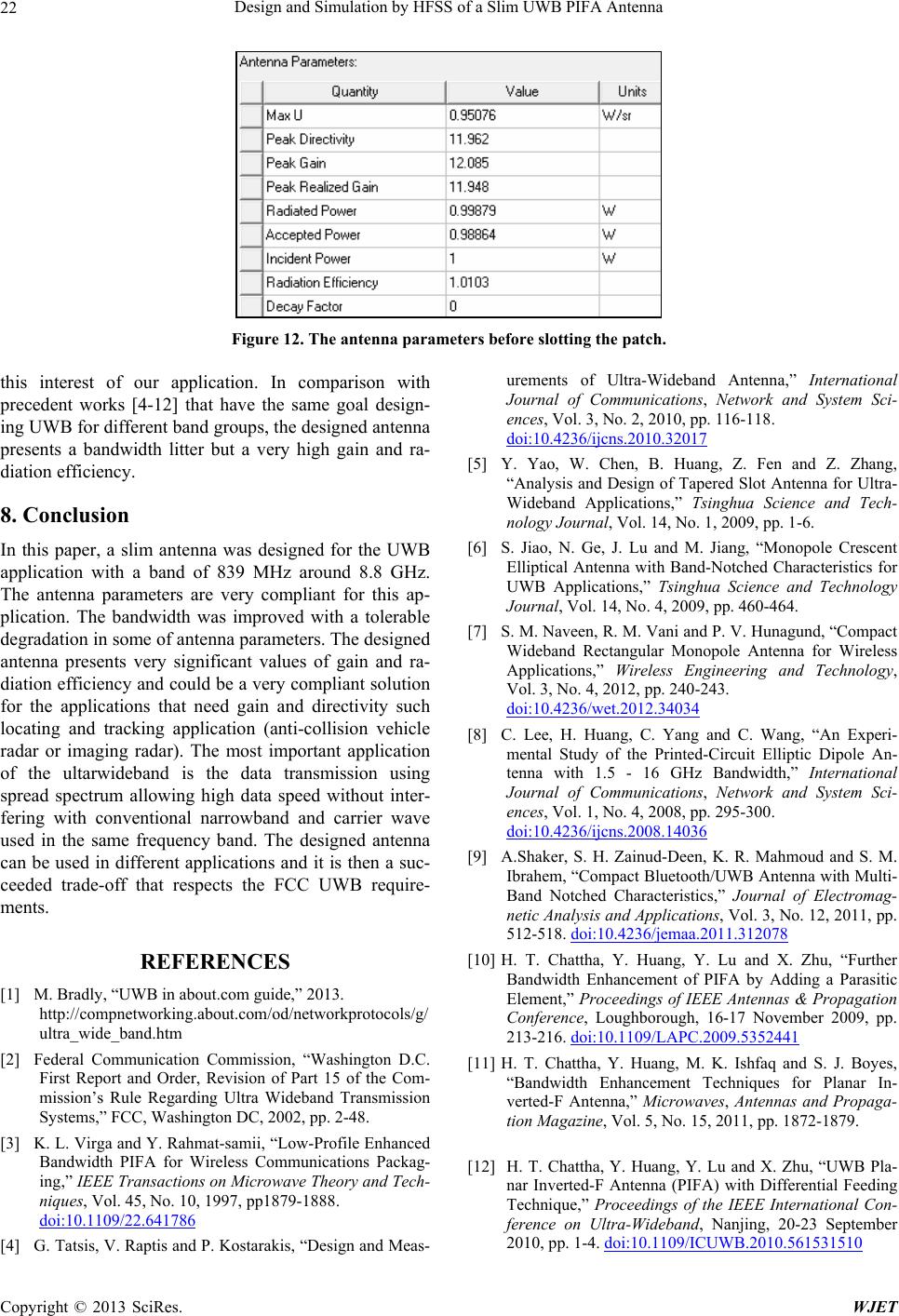
Design and Simulation by HFSS of a Slim UWB PIFA Antenna
Copyright © 2013 SciRes. WJET
22
Figure 12. The antenna parameters before slotting the patch.
this interest of our application. In comparison with
precedent works [4-12] that have the same goal design-
ing UWB for different band groups, the designed antenna
presents a bandwidth litter but a very high gain and ra-
diation efficiency.
8. Conclusion
In this paper, a slim antenna was designed for the UWB
application with a band of 839 MHz around 8.8 GHz.
The antenna parameters are very compliant for this ap-
plication. The bandwidth was improved with a tolerable
degradation in some of antenna parameters. The designed
antenna presents very significant values of gain and ra-
diation efficiency and could be a very compliant solution
for the applications that need gain and directivity such
locating and tracking application (anti-collision vehicle
radar or imaging radar). The most important application
of the ultarwideband is the data transmission using
spread spectrum allowing high data speed without inter-
fering with conventional narrowband and carrier wave
used in the same frequency band. The designed antenna
can be used in different applications and it is then a suc-
ceeded trade-off that respects the FCC UWB require-
ments.
REFERENCES
[1] M. Bradly, “UWB in about.com guide,” 2013.
http://compnetworking.about.com/od/networkprotocols/g/
ultra_wide_band.htm
[2] Federal Communication Commission, “Washington D.C.
First Report and Order, Revision of Part 15 of the Com-
mission’s Rule Regarding Ultra Wideband Transmission
Systems,” FCC, Washington DC, 2002, pp. 2-48.
[3] K. L. Virga and Y. Rahmat-samii, “Low-Profile Enhanced
Bandwidth PIFA for Wireless Communications Packag-
ing,” IEEE Transactions on Microwave Theory and Tech-
niques, Vol. 45, No. 10, 1997, pp1879-1888.
doi:10.1109/22.641786
4] G. Tatsis, V. Raptis and P. Kostarakis, “Design and Meas-
urements of Ultra-Wideband Antenna,” International
Journal of Communications, Network and Sy stem Sci-
ences, Vol. 3, No. 2, 2010, pp. 116-118.
doi:10.4236/ijcns.2010.32017
[5] Y. Yao, W. Chen, B. Huang, Z. Fen and Z. Zhang,
“Analysis and Design of Tapered Slot Antenna for Ultra-
Wideband Applications,” Tsinghua Science and Tech-
nology Journal, Vol. 14, No. 1, 2009, pp. 1-6.
[6] S. Jiao, N. Ge, J. Lu and M. Jiang, “Monopole Crescent
Elliptical Antenna with Band-Notched Characteristics for
UWB Applications,” Tsinghua Science and Technology
Journal, Vol. 14, No. 4, 2009, pp. 460-464.
[7] S. M. Naveen, R. M. Vani and P. V. Hunagund, “Compact
Wideband Rectangular Monopole Antenna for Wireless
Applications,” Wireless Engineering and Technology,
Vol. 3, No. 4, 2012, pp. 240-243.
doi:10.4236/wet.2012.34034
[8] C. Lee, H. Huang, C. Yang and C. Wang, “An Experi-
mental Study of the Printed-Circuit Elliptic Dipole An-
tenna with 1.5 - 16 GHz Bandwidth,” International
Journal of Communications, Network and Syst em Sci-
ences, Vol. 1, No. 4, 2008, pp. 295-300.
doi:10.4236/ijcns.2008.14036
[9] A.Shaker, S. H. Zainud-Deen, K. R. Mahmoud and S. M.
Ibrahem, “Compact Bluetooth/UWB Antenna with Multi-
Band Notched Characteristics,” Journal of Electromag-
netic Analysis and Applications, Vol. 3, No. 12, 2011, pp.
512-518. doi:10.4236/jemaa.2011.312078
[10] H. T. Chattha, Y. Huang, Y. Lu and X. Zhu, “Further
Bandwidth Enhancement of PIFA by Adding a Parasitic
Element,” Proceedings of IEEE Antennas & Propagation
Conference, Loughborough, 16-17 November 2009, pp.
213-216. doi:10.1109/LAPC.2009.5352441
[11] H. T. Chattha, Y. Huang, M. K. Ishfaq and S. J. Boyes,
“Bandwidth Enhancement Techniques for Planar In-
verted-F Antenna,” Microwaves, Antennas and Propaga-
tion Magazine, Vol. 5, No. 15, 2011, pp. 1872-1879.
[12] H. T. Chattha, Y. Huang, Y. Lu and X. Zhu, “UWB Pla-
nar Inverted-F Antenna (PIFA) with Differential Feeding
Technique,” Proceedings of the IEEE International Con-
ference on Ultra-Wideband, Nanjing, 20-23 September
2010, pp. 1-4. doi:10.1109/ICUWB.2010.561531510
[